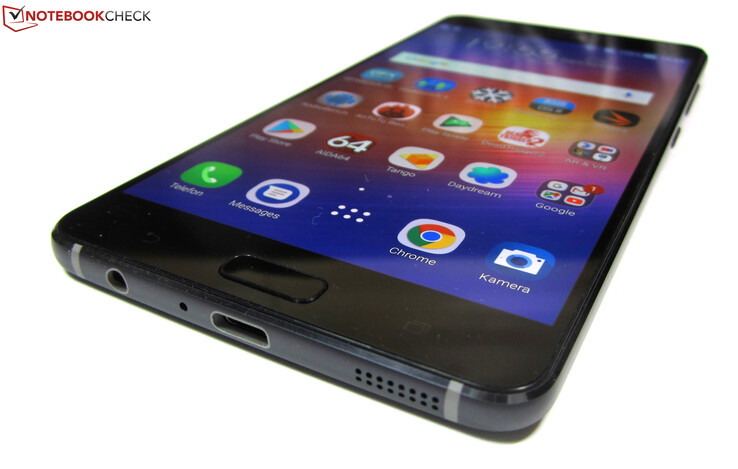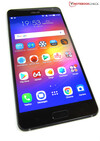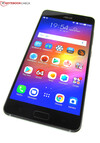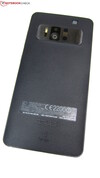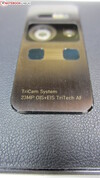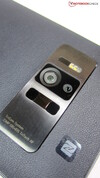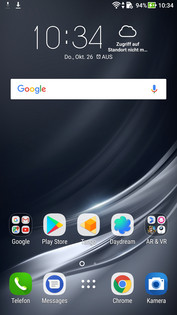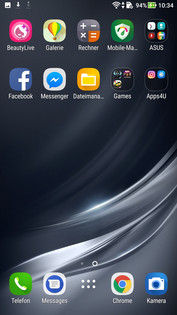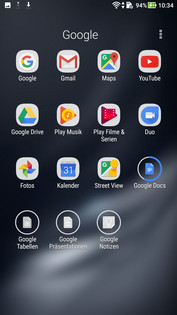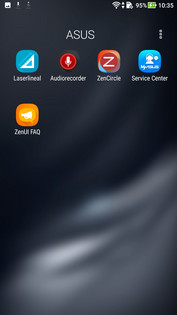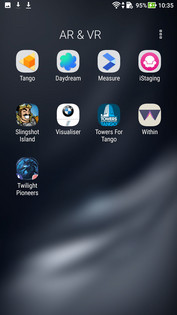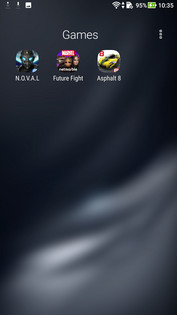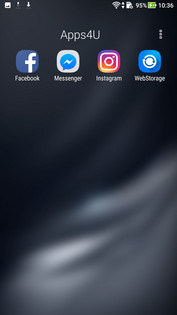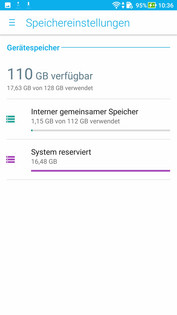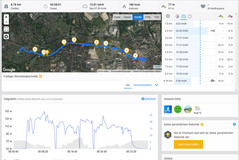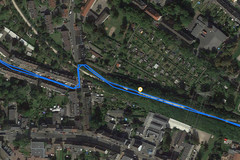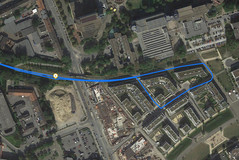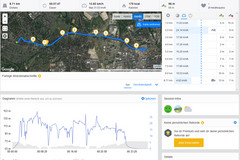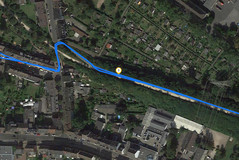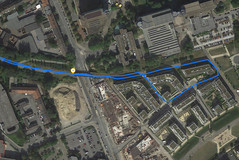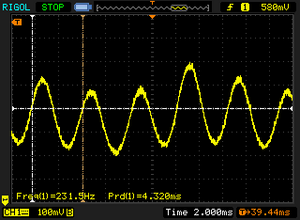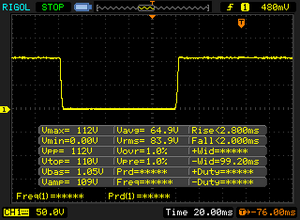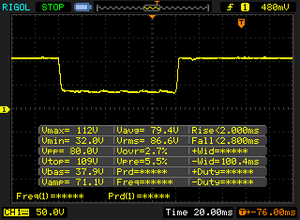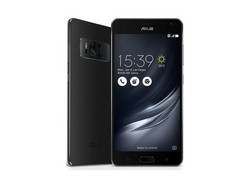Test: Asus ZenFone AR (ZS571KL) Smartphone (Sammanfattning)
Topp 10...
» Topp 10: Bästa bärbara allround/multimediadatorerna
» Topp 10: Bästa bärbara speldatorerna
» Topp 10: Bärbara budget/kontorsdatorer
» Topp 10: Bästa bärbara kontors/premiumdatorerna
» Topp 10: Bärbara arbetsstationer
» Topp 10: De bästa små/kompakta bärbara datorerna
» Topp 10: Bästa ultrabooks
» Topp 10: Bästa hybriddatorerna
» Topp 10: Bästa surfplattorna
» Topp 10: Marknadens bästa smartphones
Size Comparison
| Networking | |
| iperf3 transmit AX12 | |
| Samsung Galaxy S8 | |
| OnePlus 5 | |
| Apple iPhone 8 | |
| Asus ZenFone AR ZS571KL | |
| Lenovo Phab 2 Pro | |
| LG G6 | |
| iperf3 receive AX12 | |
| Apple iPhone 8 | |
| OnePlus 5 | |
| Asus ZenFone AR ZS571KL | |
| Samsung Galaxy S8 | |
| LG G6 | |
| Lenovo Phab 2 Pro | |
| |||||||||||||||||||||||||
Distribution av ljusstyrkan: 90 %
Mitt på batteriet: 338 cd/m²
Kontrast: ∞:1 (Svärta: 0 cd/m²)
ΔE ColorChecker Calman: 3.7 | ∀{0.5-29.43 Ø4.78}
ΔE Greyscale Calman: 4.9 | ∀{0.09-98 Ø5}
Gamma: 2.25
CCT: 7286 K
| Asus ZenFone AR ZS571KL Super AMOLED, 2560x1440, 5.7" | Lenovo Phab 2 Pro IPS, 2560x1440, 6.4" | Apple iPhone 8 IPS True Tone, 1334x750, 4.7" | LG G6 IPS LCD, 2880x1440, 5.7" | Samsung Galaxy S8 Super AMOLED, 2960x1440, 5.8" | OnePlus 5 AMOLED, 1920x1080, 5.5" | |
|---|---|---|---|---|---|---|
| Screen | -18% | 59% | 20% | 39% | 38% | |
| Brightness middle (cd/m²) | 338 | 472.4 40% | 604 79% | 646 91% | 566 67% | 426 26% |
| Brightness (cd/m²) | 341 | 479 40% | 580 70% | 611 79% | 564 65% | 431 26% |
| Brightness Distribution (%) | 90 | 93 3% | 91 1% | 89 -1% | 94 4% | 93 3% |
| Black Level * (cd/m²) | 0.482 | 0.44 | 0.23 | |||
| Colorchecker dE 2000 * | 3.7 | 7 -89% | 1.2 68% | 4.5 -22% | 2.7 27% | 1.6 57% |
| Colorchecker dE 2000 max. * | 7.9 | 11 -39% | 2.3 71% | 8.3 -5% | 5.4 32% | 4.1 48% |
| Greyscale dE 2000 * | 4.9 | 7.9 -61% | 1.6 67% | 6 -22% | 3.1 37% | 1.7 65% |
| Gamma | 2.25 98% | 2.34 94% | 2.25 98% | 2.27 97% | 2.15 102% | 2.25 98% |
| CCT | 7286 89% | 7826 83% | 6688 97% | 7996 81% | 6335 103% | 6329 103% |
| Contrast (:1) | 980 | 1373 | 2809 | |||
| Color Space (Percent of AdobeRGB 1998) (%) | 67.74 | 81.57 | ||||
| Color Space (Percent of sRGB) (%) | 99.05 | 99.87 |
* ... mindre är bättre
Skärmflimmer / PWM (Puls-Width Modulation)
| Skärmflimmer / PWM upptäckt | 231.5 Hz | ||
Displayens bakgrundsbelysning flimrar vid 231.5 Hz (i värsta fall, t.ex. med PWM) . Frekvensen för 231.5 Hz är relativt låg, så känsliga användare kommer sannolikt att märka flimmer och uppleva ansträngda ögon vid den angivna ljusstyrkeinställningen och nedan. Som jämförelse: 53 % av alla testade enheter använder inte PWM för att dämpa skärmen. Om PWM upptäcktes mättes ett medelvärde av 8118 (minst: 5 - maximum: 343500) Hz. | |||
Visa svarstider
| ↔ Svarstid svart till vitt | ||
|---|---|---|
| 4.8 ms ... stiga ↗ och falla ↘ kombinerat | ↗ 2.8 ms stiga | |
| ↘ 2 ms hösten | ||
| Skärmen visar väldigt snabba svarsfrekvenser i våra tester och borde vara mycket väl lämpad för fartfyllt spel. I jämförelse sträcker sig alla testade enheter från 0.1 (minst) till 240 (maximalt) ms. » 16 % av alla enheter är bättre. Det betyder att den uppmätta svarstiden är bättre än genomsnittet av alla testade enheter (20.2 ms). | ||
| ↔ Svarstid 50 % grått till 80 % grått | ||
| 4.8 ms ... stiga ↗ och falla ↘ kombinerat | ↗ 2 ms stiga | |
| ↘ 2.8 ms hösten | ||
| Skärmen visar väldigt snabba svarsfrekvenser i våra tester och borde vara mycket väl lämpad för fartfyllt spel. I jämförelse sträcker sig alla testade enheter från 0.165 (minst) till 636 (maximalt) ms. » 15 % av alla enheter är bättre. Det betyder att den uppmätta svarstiden är bättre än genomsnittet av alla testade enheter (31.6 ms). | ||
| AnTuTu v6 - Total Score (sortera efter värde) | |
| Asus ZenFone AR ZS571KL | |
| Lenovo Phab 2 Pro | |
| Apple iPhone 8 | |
| LG G6 | |
| Samsung Galaxy S8 | |
| OnePlus 5 | |
| PCMark for Android | |
| Work performance score (sortera efter värde) | |
| Asus ZenFone AR ZS571KL | |
| LG G6 | |
| Samsung Galaxy S8 | |
| OnePlus 5 | |
| Work 2.0 performance score (sortera efter värde) | |
| Asus ZenFone AR ZS571KL | |
| LG G6 | |
| Samsung Galaxy S8 | |
| OnePlus 5 | |
| Geekbench 4.4 | |
| 64 Bit Single-Core Score (sortera efter värde) | |
| Asus ZenFone AR ZS571KL | |
| Apple iPhone 8 | |
| LG G6 | |
| Samsung Galaxy S8 | |
| OnePlus 5 | |
| 64 Bit Multi-Core Score (sortera efter värde) | |
| Asus ZenFone AR ZS571KL | |
| Apple iPhone 8 | |
| LG G6 | |
| Samsung Galaxy S8 | |
| OnePlus 5 | |
| Compute RenderScript Score (sortera efter värde) | |
| LG G6 | |
| Samsung Galaxy S8 | |
| OnePlus 5 | |
| GFXBench (DX / GLBenchmark) 2.7 | |
| T-Rex Onscreen (sortera efter värde) | |
| Asus ZenFone AR ZS571KL | |
| Lenovo Phab 2 Pro | |
| Apple iPhone 8 | |
| LG G6 | |
| Samsung Galaxy S8 | |
| OnePlus 5 | |
| 1920x1080 T-Rex Offscreen (sortera efter värde) | |
| Asus ZenFone AR ZS571KL | |
| Lenovo Phab 2 Pro | |
| Apple iPhone 8 | |
| LG G6 | |
| Samsung Galaxy S8 | |
| OnePlus 5 | |
| GFXBench 3.0 | |
| on screen Manhattan Onscreen OGL (sortera efter värde) | |
| Asus ZenFone AR ZS571KL | |
| Lenovo Phab 2 Pro | |
| Apple iPhone 8 | |
| LG G6 | |
| Samsung Galaxy S8 | |
| OnePlus 5 | |
| 1920x1080 1080p Manhattan Offscreen (sortera efter värde) | |
| Asus ZenFone AR ZS571KL | |
| Lenovo Phab 2 Pro | |
| Apple iPhone 8 | |
| LG G6 | |
| Samsung Galaxy S8 | |
| OnePlus 5 | |
| GFXBench 3.1 | |
| on screen Manhattan ES 3.1 Onscreen (sortera efter värde) | |
| Asus ZenFone AR ZS571KL | |
| Lenovo Phab 2 Pro | |
| Apple iPhone 8 | |
| LG G6 | |
| Samsung Galaxy S8 | |
| OnePlus 5 | |
| 1920x1080 Manhattan ES 3.1 Offscreen (sortera efter värde) | |
| Asus ZenFone AR ZS571KL | |
| Lenovo Phab 2 Pro | |
| Apple iPhone 8 | |
| LG G6 | |
| Samsung Galaxy S8 | |
| OnePlus 5 | |
| GFXBench | |
| on screen Car Chase Onscreen (sortera efter värde) | |
| Asus ZenFone AR ZS571KL | |
| Lenovo Phab 2 Pro | |
| LG G6 | |
| Samsung Galaxy S8 | |
| OnePlus 5 | |
| 1920x1080 Car Chase Offscreen (sortera efter värde) | |
| Asus ZenFone AR ZS571KL | |
| Lenovo Phab 2 Pro | |
| LG G6 | |
| Samsung Galaxy S8 | |
| OnePlus 5 | |
| JetStream 1.1 - Total Score | |
| Apple iPhone 8 | |
| OnePlus 5 (Chrome 59) | |
| Samsung Galaxy S8 (Samsung Browser 5.2) | |
| Asus ZenFone AR ZS571KL (Chrome 58.0.3029.83) | |
| LG G6 (Chrome 57) | |
| Lenovo Phab 2 Pro (Chrome 54.0.2840.85) | |
| Octane V2 - Total Score | |
| Apple iPhone 8 | |
| Samsung Galaxy S8 (Samsung Browser 5.2) | |
| OnePlus 5 (Chrome 59) | |
| Asus ZenFone AR ZS571KL (Chrome 58.0.3029.83) | |
| LG G6 (Chrome 57) | |
| Lenovo Phab 2 Pro (Chrome 54.0.2840.85) | |
| Mozilla Kraken 1.1 - Total | |
| Lenovo Phab 2 Pro (Chrome 54.0.2840.85) | |
| OnePlus 5 (Chrome 59) | |
| LG G6 (Chrome 57) | |
| Asus ZenFone AR ZS571KL (Chrome 58.0.3029.83) | |
| Samsung Galaxy S8 (Samsung Browser 5.2) | |
| Apple iPhone 8 | |
| WebXPRT 2015 - Overall | |
| Apple iPhone 8 | |
| Samsung Galaxy S8 (Samsung Browser 5.2) | |
| OnePlus 5 (Chrome 59) | |
| Asus ZenFone AR ZS571KL (Chrome 58.0.3029.83) | |
| LG G6 (Chrome 57) | |
| Lenovo Phab 2 Pro | |
* ... mindre är bättre
| Asus ZenFone AR ZS571KL | Lenovo Phab 2 Pro | LG G6 | Samsung Galaxy S8 | OnePlus 5 | |
|---|---|---|---|---|---|
| AndroBench 3-5 | -22% | -2% | 21% | 52% | |
| Sequential Read 256KB (MB/s) | 458.9 | 255 -44% | 428.7 -7% | 793 73% | 748 63% |
| Sequential Write 256KB (MB/s) | 142.8 | 138 -3% | 122.8 -14% | 193.2 35% | 201.5 41% |
| Random Read 4KB (MB/s) | 88.4 | 38.53 -56% | 95.2 8% | 127.2 44% | 141 60% |
| Random Write 4KB (MB/s) | 13.51 | 12.92 -4% | 16.58 23% | 15.25 13% | 19.3 43% |
| Sequential Read 256KB SDCard (MB/s) | 83.4 ? | 71.9 ? -14% | 77.6 ? -7% | 63.9 ? -23% | |
| Sequential Write 256KB SDCard (MB/s) | 62.6 ? | 54.8 ? -12% | 53.3 ? -15% | 53.5 ? -15% |
| Dead Trigger 2 | |||
| Inställningar | Värde | ||
| high | 56 fps | ||
| Asphalt 8: Airborne | |||
| Inställningar | Värde | ||
| high | 30 fps | ||
| very low | 30 fps | ||
(+) Den maximala temperaturen på ovansidan är 37.8 °C / 100 F, jämfört med genomsnittet av 35.2 °C / 95 F , allt från 21.9 till 247 °C för klassen Smartphone.
(+) Botten värms upp till maximalt 37.9 °C / 100 F, jämfört med genomsnittet av 34 °C / 93 F
(+) Vid tomgångsbruk är medeltemperaturen för ovansidan 25.8 °C / 78 F, jämfört med enhetsgenomsnittet på 32.9 °C / ### class_avg_f### F.
Asus ZenFone AR ZS571KL ljudanalys
(+) | högtalare kan spela relativt högt (88.4 dB)
Bas 100 - 315 Hz
(-) | nästan ingen bas - i genomsnitt 24.7% lägre än medianen
(±) | linjäriteten för basen är genomsnittlig (9.8% delta till föregående frekvens)
Mellan 400 - 2000 Hz
(+) | balanserad mellan - endast 3.6% från medianen
(+) | mids är linjära (4.2% delta till föregående frekvens)
Högsta 2 - 16 kHz
(±) | högre toppar - i genomsnitt 8.6% högre än medianen
(+) | toppar är linjära (6.8% delta till föregående frekvens)
Totalt 100 - 16 000 Hz
(±) | linjäriteten för det totala ljudet är genomsnittlig (21.6% skillnad mot median)
Jämfört med samma klass
» 42% av alla testade enheter i den här klassen var bättre, 8% liknande, 50% sämre
» Den bästa hade ett delta på 11%, genomsnittet var 35%, sämst var 134%
Jämfört med alla testade enheter
» 60% av alla testade enheter var bättre, 7% liknande, 33% sämre
» Den bästa hade ett delta på 4%, genomsnittet var 24%, sämst var 134%
Lenovo Phab 2 Pro ljudanalys
(+) | högtalare kan spela relativt högt (84.5 dB)
Bas 100 - 315 Hz
(-) | nästan ingen bas - i genomsnitt 22.8% lägre än medianen
(±) | linjäriteten för basen är genomsnittlig (11.4% delta till föregående frekvens)
Mellan 400 - 2000 Hz
(+) | balanserad mellan - endast 2.2% från medianen
(+) | mids är linjära (4.7% delta till föregående frekvens)
Högsta 2 - 16 kHz
(±) | högre toppar - i genomsnitt 6.3% högre än medianen
(±) | linjäriteten för toppar är genomsnittlig (7.3% delta till föregående frekvens)
Totalt 100 - 16 000 Hz
(±) | linjäriteten för det totala ljudet är genomsnittlig (21.1% skillnad mot median)
Jämfört med samma klass
» 39% av alla testade enheter i den här klassen var bättre, 8% liknande, 53% sämre
» Den bästa hade ett delta på 11%, genomsnittet var 35%, sämst var 134%
Jämfört med alla testade enheter
» 57% av alla testade enheter var bättre, 7% liknande, 35% sämre
» Den bästa hade ett delta på 4%, genomsnittet var 24%, sämst var 134%
Apple iPhone 8 ljudanalys
(±) | högtalarljudstyrkan är genomsnittlig men bra (78.4 dB)
Bas 100 - 315 Hz
(±) | reducerad bas - i genomsnitt 14.6% lägre än medianen
(±) | linjäriteten för basen är genomsnittlig (9.2% delta till föregående frekvens)
Mellan 400 - 2000 Hz
(+) | balanserad mellan - endast 4.3% från medianen
(+) | mids är linjära (4.2% delta till föregående frekvens)
Högsta 2 - 16 kHz
(±) | högre toppar - i genomsnitt 5.1% högre än medianen
(+) | toppar är linjära (4.7% delta till föregående frekvens)
Totalt 100 - 16 000 Hz
(±) | linjäriteten för det totala ljudet är genomsnittlig (18.2% skillnad mot median)
Jämfört med samma klass
» 17% av alla testade enheter i den här klassen var bättre, 8% liknande, 74% sämre
» Den bästa hade ett delta på 11%, genomsnittet var 35%, sämst var 134%
Jämfört med alla testade enheter
» 38% av alla testade enheter var bättre, 8% liknande, 54% sämre
» Den bästa hade ett delta på 4%, genomsnittet var 24%, sämst var 134%
| Av/Standby | |
| Låg belastning | |
| Hög belastning |
|
Förklaring:
min: | |
| Asus ZenFone AR ZS571KL 3300 mAh | Lenovo Phab 2 Pro 4050 mAh | Apple iPhone 8 1821 mAh | LG G6 3300 mAh | Samsung Galaxy S8 3000 mAh | OnePlus 5 3300 mAh | |
|---|---|---|---|---|---|---|
| Power Consumption | -147% | 10% | 1% | 23% | -1% | |
| Idle Minimum * (Watt) | 0.88 | 3 -241% | 0.54 39% | 0.62 30% | 0.78 11% | 0.73 17% |
| Idle Average * (Watt) | 1.24 | 4.1 -231% | 1.63 -31% | 1.43 -15% | 1.1 11% | 1.44 -16% |
| Idle Maximum * (Watt) | 1.26 | 4.2 -233% | 1.67 -33% | 1.48 -17% | 1.16 8% | 1.5 -19% |
| Load Average * (Watt) | 7.71 | 10.4 -35% | 2.74 64% | 5.52 28% | 4.15 46% | 6.91 10% |
| Load Maximum * (Watt) | 8.64 | 8.1 6% | 7.78 10% | 10.47 -21% | 5.12 41% | 8.51 2% |
* ... mindre är bättre
| Asus ZenFone AR ZS571KL 3300 mAh | Lenovo Phab 2 Pro 4050 mAh | Apple iPhone 8 1821 mAh | LG G6 3300 mAh | Samsung Galaxy S8 3000 mAh | OnePlus 5 3300 mAh | |
|---|---|---|---|---|---|---|
| Batteridrifttid | -8% | 11% | 28% | 29% | 7% | |
| Reader / Idle (h) | 24.6 | 18.7 -24% | 27.2 11% | 29.8 21% | 27.8 13% | 25.6 4% |
| H.264 (h) | 10.6 | 9.5 -10% | 11.6 9% | 13 23% | 12.9 22% | 10.4 -2% |
| WiFi v1.3 (h) | 7.4 | 8.5 15% | 9.8 32% | 11.5 55% | 12 62% | 8.6 16% |
| Load (h) | 3.7 | 3.2 -14% | 3.4 -8% | 4.2 14% | 4.4 19% | 4.1 11% |
För
Emot
Ingen tvekan: ZenFone AR är den första smartphone som kör Googles Tango-appar för Förstärkt Verklighet smidigt. Men med tanke på det relativt låga antalet appar (runt 30) - dom flesta är dessutom gimmicks - så är Tango i det sitt nuvarande tillstånd inte en funktion man känner att man måste ha. Frågan är: är du villig att spendera ~6 700 SEK ($800) plus moms för denna ganska dåliga AR-upplevelse? Vi misstänker att för dom flesta användare kommer Tango inte vara en avgörande faktor i övervägandet av ZenFone AR, särskilt då Googles Daydream VR-glasögon inte är inkluderade och måste köpas separat.
Att köpa ZenFone AR bara för Google Tango kommer inte vara värt det. Det som blir kvar vid sidan om förstärkt verklighet är en duglig men dyr smartphone.
LG G6 är lika snabb som ZenFone AR för bara halva priset. Asus TriCam kunde inte heller imponera på oss. Ja, dom resulterande bilderna är definitivt skapliga, men dom är långt ifrån bäst. Dessutom är batteritiden väldigt dålig och ZenFone AR får slut på soppa jämförelsevis snabbt.
I slutändan är Asus ZenFone AR en välgjord, högkvalitativ smartphone med WQHD OLED-skärm, mer än nödvändig prestanda för vardagliga appar och spel och väldigt snabba kommunikationsmoduler.
Asus ZenFone AR ZS571KL
- 11/02/2017 v6 (old)
Manuel Masiero




